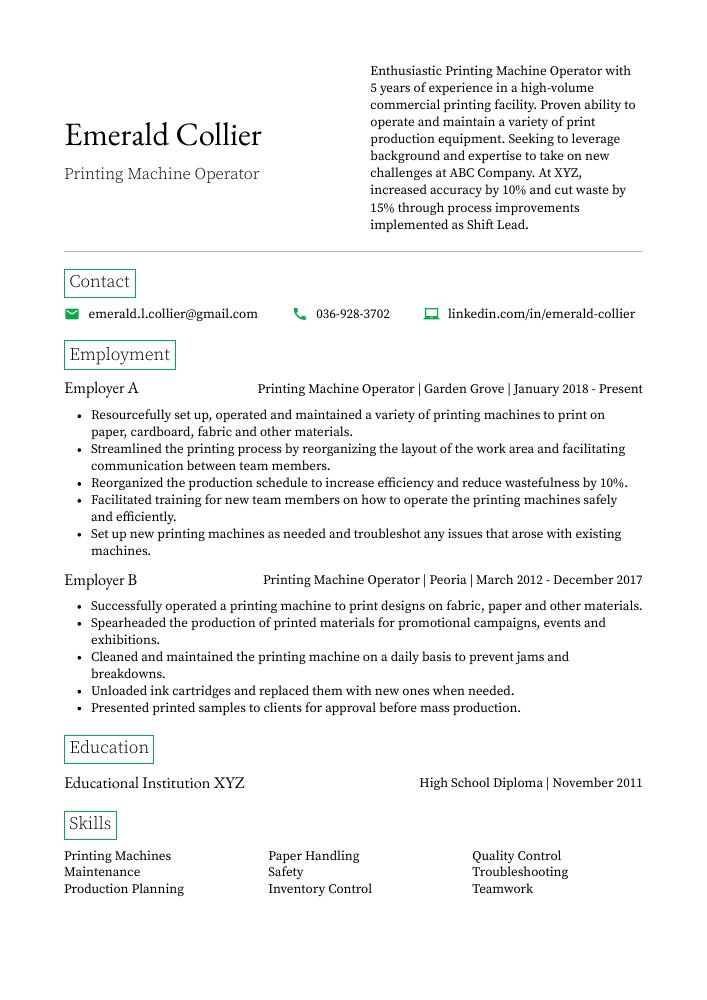Printing Machine Operator Resume Guide
Printing machine operators are responsible for the set up, maintenance, and operation of printing machines. They ensure that the machines are running properly and produce high-quality prints. Printing machine operators must be highly skilled in order to troubleshoot any issues that may arise.
You know the ins and outs of every printing machine like the back of your hand. But your future employer won’t know that unless you write a resume that demonstrates your superior skillset.
This guide will walk you through the entire process of creating a top-notch resume. We first show you a complete example and then break down what each resume section should look like.
Table of Contents
The guide is divided into sections for your convenience. You can read it from beginning to end or use the table of contents below to jump to a specific part.
Printing Machine Operator Resume Sample
Alexandro Stiedemann
Printing Machine Operator
[email protected]
536-670-1917
linkedin.com/in/alexandro-stiedemann
Summary
Enthusiastic Printing Machine Operator with 5 years of experience in a high-volume commercial printing facility. Proven ability to operate and maintain a variety of print production equipment. Seeking to leverage background and expertise to take on new challenges at ABC Company. At XYZ, increased accuracy by 10% and cut waste by 15% through process improvements implemented as Shift Lead.
Experience
Printing Machine Operator, Employer A
Fullerton, Jan 2018 – Present
- Resourcefully set up, operated and maintained a variety of printing machines to print on paper, cardboard, fabric and other materials.
- Streamlined the printing process by reorganizing the layout of the work area and facilitating communication between team members.
- Reorganized the production schedule to increase efficiency and reduce wastefulness by 10%.
- Facilitated training for new team members on how to operate the printing machines safely and efficiently.
- Set up new printing machines as needed and troubleshot any issues that arose with existing machines.
Printing Machine Operator, Employer B
McAllen, Mar 2012 – Dec 2017
- Successfully operated a printing machine to print designs on fabric, paper and other materials.
- Spearheaded the production of printed materials for promotional campaigns, events and exhibitions.
- Cleaned and maintained the printing machine on a daily basis to prevent jams and breakdowns.
- Unloaded ink cartridges and replaced them with new ones when needed.
- Presented printed samples to clients for approval before mass production.
Skills
- Printing Machines
- Paper Handling
- Quality Control
- Maintenance
- Safety
- Troubleshooting
- Production Planning
- Inventory Control
- Teamwork
Education
High School Diploma
Educational Institution XYZ
Nov 2011
Certifications
Certified Printing Machine Operator
National Print Owners Association
May 2017
1. Summary / Objective
The summary/objective at the top of your resume is like a teaser – it provides the employer with a snapshot of who you are and what makes you an excellent printing machine operator. Here, you can highlight your key skills and experience, such as your ability to operate various types of printing machines, your experience working in a fast-paced environment, and your strong attention to detail.
Below are some resume summary examples:
Amicable and detail-oriented printing machine operator with 3+ years of experience overseeing the daily operations of a printing press. Seeking to join ABC Print Shop where I can use my organizational skills and production knowledge to streamline processes and improve customer satisfaction. In previous roles increased efficiency by 15% while also reducing waste by 10%.
Professional printing machine operator with 6+ years of experience working in a high-volume print shop. Seeking to leverage expertise in CNC and digital printing technology to add value at ABC company. At XYZ, operated 12 different machines and achieved 97% on-time delivery for 500+ clients. Recognized as “Employee of the Month” 3 times for superior performance.
Reliable Printing Machine Operator with 4+ years of experience in running and maintaining high-speed printers. Seeking to leverage my skills and knowledge to grow with ABC company. At XYZ, increased printer uptime by 10% due to diligent maintenance techniques. Also, trained new operators which resulted in 30% less errors during their first 3 months on the job.
Skilled printing machine operator with 5+ years of experience in the printing industry. Efficiently and accurately operate high-speed printers while maintaining quality standards. Experienced in set up, operation, and maintenance of a variety of print equipment. Adept at performing preventive maintenance on machines and troubleshooting issues as they arise.
Proficient Printing Machine Operator with more than 5 years of experience in the printing industry. Experience includes working on both conventional and digital presses. At XYZ, printed 10,000+ pages per day on an 8-color Heidelberg Speedmaster 74 press. Consistently produced high-quality prints while meeting deadlines and maintaining a low error rate.
Seasoned printing machine operator with 7+ years of experience in a fast-paced, high volume printing environment. Seeking to leverage expertise in color accuracy and print quality control to fill the Printing Machine Operator role at ABC Company. At XYZ Inc., increased productivity by 10% due to implementation of new process improvements.
Diligent Printing Machine Operator with 3+ years of experience in a high-volume print production environment. Exceptional time management skills; able to operate multiple machines simultaneously while meeting tight deadlines. Seeking to leverage abilities to become the next Printing Machine Operator at ABC company.
2. Experience / Employment
In the experience or employment section, you will list your work history in reverse chronological order. This means that your most recent job should be at the top of the page.
When writing about your experience, it is best to use bullet points. This allows the reader to quickly digest the information you are providing. When writing each bullet point, make sure to include details about what you did and any results that were achieved.
For example, instead of saying “Operated a printing machine,” you could say “Successfully operated a printing machine for 8 hours per day with no errors, resulting in 100% accurate print jobs.”.
To write effective bullet points, begin with a strong verb or adverb. Industry specific verbs to use are:
- Operated
- Monitored
- Maintained
- Set
- Adjusted
- Inspected
- Cleaned
- Tested
- Troubleshot
- Repaired
- Replaced
- Loaded
- Unloaded
- Coordinated
- Trained
Other general verbs you can use are:
- Achieved
- Advised
- Assessed
- Compiled
- Demonstrated
- Developed
- Expedited
- Facilitated
- Formulated
- Improved
- Introduced
- Mentored
- Optimized
- Participated
- Prepared
- Presented
- Reduced
- Reorganized
- Represented
- Revised
- Spearheaded
- Streamlined
- Structured
- Utilized
Below are some example bullet points:
- Accurately operated printing machines to print designs on fabric, paper and other materials.
- Troubleshot machine malfunctions and errors, quickly fixing them to avoid production delays.
- Achieved daily targets for number of prints produced, while maintaining high standards of quality.
- Expedited orders by working overtime when necessary, without compromising on quality or safety standards.
- Formulated new ideas for print designs based on customer feedback and market trends; created over 100 unique designs that were well-received by customers.
- Utilized 3 color printing machines to produce high-quality prints for a wide range of materials, including paper, cardstock, fabric, and vinyl.
- Developed an expert understanding of the inner workings of each machine, allowing me to quickly diagnose and solve problems when they arose.
- Adjusted settings on machines according to specific instructions in order to achieve desired results with regards to print quality, speed, and cost-efficiency.
- Repaired broken or damaged parts on machines as necessary; able to complete repairs in an average of 2 hours per machine.
- Structured work shifts for a team of 10 print machine operators, ensuring adequate coverage and minimizing overtime costs.
- Independently operated and maintained 3 high-speed printing machines, producing an average of 10,000 printed products per day.
- Assessed print job orders to determine the most efficient production method and allocated resources accordingly.
- Mentored new employees on proper machine operation and safety procedures; helped reduce incidents by 23%.
- Compiled weekly reports detailing operational statistics and outlining any areas needing improvement; identified a 5% decrease in productivity due to paper jams caused by operator error.
- Inspected print job orders to determine specifications, such as production times, quantities, stock types and color requirements.
- Effectively operated high-speed printing machines in a safe and efficient manner, while adhering to all company safety guidelines and procedures.
- Trained new employees on proper machine operation techniques and best practices for quality control measures; reduced training time by 50%.
- Reduced downtime of machines by 15% through regular maintenance checks and proactive troubleshooting of potential issues before they arose.
- Maintained an accurate inventory of all print supplies at all times, reordering as needed to avoid disruptions in production; lowered supply costs by 10%.
- Represented the company in a positive and professional manner at all times.
- Reliably operated printing machines to print high-quality documents, labels and packaging products.
- Tested newly installed machines and equipment to ensure optimal performance before use.
- Coordinated with other departments to resolve any issues or problems that arose during production runs.
- Loaded paper into printers and performed regular maintenance tasks such as cleaning, oiling and lubricating parts, to keep machines running smoothly.
- Operated a printing machine for 8 hours a day, 5 days a week; printed out an average of 500 pages per hour with 0% errors.
- Demonstrated excellent hand-eye coordination and attention to detail when setting up the machine, loading paper and checking printouts for quality control purposes.
- Introduced a new color-coding system for print jobs which helped to reduce confusion and wasted time among co-workers by 25%.
- Diligently cleaned and maintained the printing machine on a daily basis according to company guidelines, resulting in fewer maintenance issues and downtime instances.
- Participated in weekly team meetings to discuss ways to improve print quality, speed and efficiency; suggested using heavier paper stock for certain jobs which was then implemented with positive results.
- Replaced rollers, inks and other printing materials as needed to maintain optimal performance of machines; decreased downtime by 15%.
- Optimized machine settings for each job type to achieve the best results in terms of color, clarity and overall quality; improved customer satisfaction ratings by 3%.
- Revised production schedules as needed in order to accommodate rush orders and unexpected changes in customer demand; maintained on-time delivery rate at 98%.
- Prepared detailed activity reports documenting all issues encountered during shift and outlining possible solutions; helped troubleshoot machinery problems faster.
- Proficiently operated up to 4 printing presses simultaneously while adhering to all safety regulations and standards.
3. Skills
The skills required for a Printing Machine Operator will differ from employer to employer, so it’s important that you tailor the skills section of your resume to each job that you are applying for.
Some companies might require experience with specific types of printing machines, while others might place more emphasis on customer service skills. By assessing the required skills in each job posting, you can easily determine which ones to highlight in your resume.
It is also essential to keep in mind that many employers use applicant tracking systems these days, which scan resumes for certain keywords before passing them on to a human. Therefore, including the right keywords in your resume is crucial if you want it to be seen by a hiring manager.
Below is a list of common skills & terms:
- Inventory Control
- Maintenance
- Paper Handling
- Printing Machines
- Production Planning
- Quality Control
- Safety
- Teamwork
- Troubleshooting
4. Education
Including an education section on your resume will depend on how far along you are in your career. If you just graduated and have no work experience, list your education below your resume objective. However, if you have been working in the printing industry for years and at multiple companies with plenty of different responsibilities to showcase, omitting the education section is perfectly fine.
If an education section is included, you could mention courses taken or subjects studied related to the printing machine operator job you are applying for. For example “Courses included Digital Pre-Press Production, Lithography Principles & Practices.”.
High School Diploma
Educational Institution XYZ
Nov 2011
5. Certifications
Certifications give potential employers an extra sense of security when hiring you. They know that you have been tested and found to be competent in a particular area.
If you are applying for a job that requires specific certifications, list them prominently in this section of your resume. Doing so will give you a leg up on the competition and show that you are truly invested in the field.
Certified Printing Machine Operator
National Print Owners Association
May 2017
6. Contact Info
Your name should be the first thing a reader sees when viewing your resume, so ensure its positioning is prominent. Your phone number should be written in the most commonly used format in your country/city/state, and your email address should be professional.
You can also choose to include a link to your LinkedIn profile, personal website, or other online platforms relevant to your industry.
Finally, name your resume file appropriately to help hiring managers; for Alexandro Stiedemann, this would be Alexandro-Stiedemann-resume.pdf or Alexandro-Stiedemann-resume.docx.
7. Cover Letter
A cover letter is a 2-4 paragraph document that is sent along with your resume when applying for jobs. It provides additional information about you and why you would be a good fit for the role. .
Cover letters are not always required, but they can give you an edge over other candidates by allowing you to introduce yourself and explain why you are the best person for the job.
Below is an example cover letter:
Dear Lysanne,
I am writing to apply for the Printing Machine Operator position at your company. With five years of experience in the printing industry and a strong background in machine operation, I am confident I would be a valuable asset to your team.
In my current role as Printing Machine Operator at XYZ Company, I operate high-speed printing presses and perform quality control checks on printed materials. I have experience with a variety of machines and am familiar with troubleshooting common issues. In addition, I work well under pressure and can meet deadlines even when production is running behind schedule.
I believe my skills and experience make me an ideal candidate for the Printing Machine Operator position at your company. I look forward to speaking with you soon about this opportunity. Thank you for your time and consideration.
Sincerely,
Alexandro
Printing Machine Operator Resume Templates
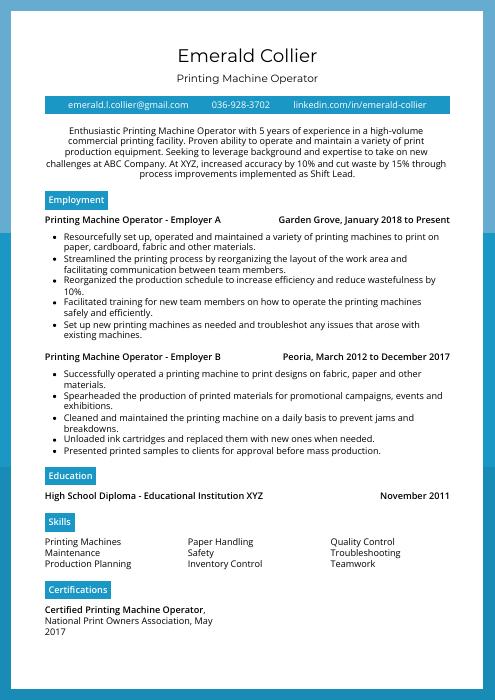 Rhea
Rhea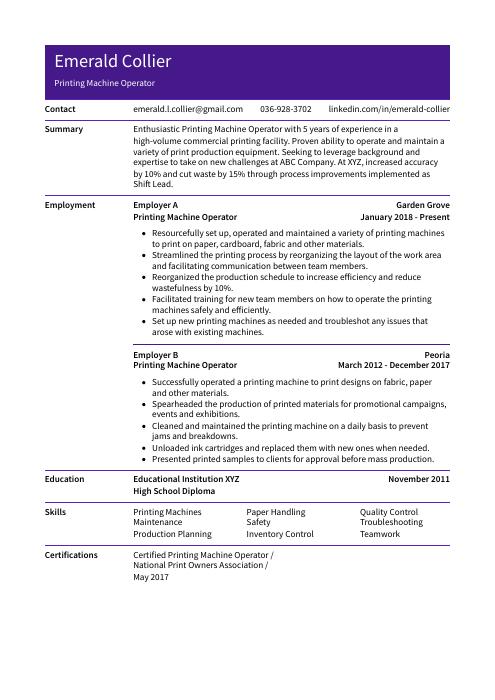 Pika
Pika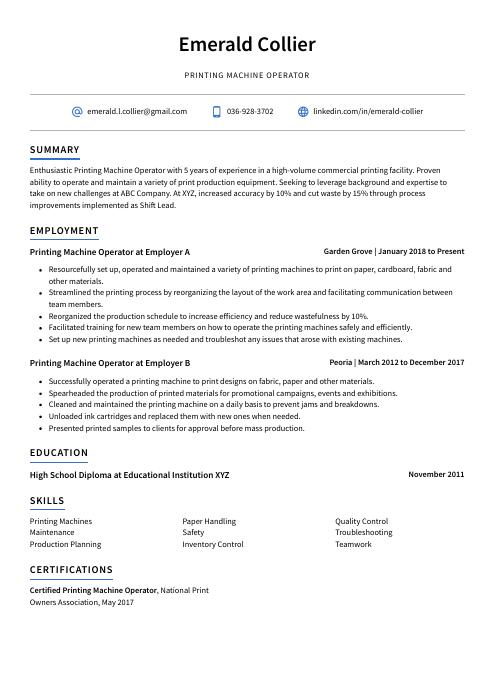 Axolotl
Axolotl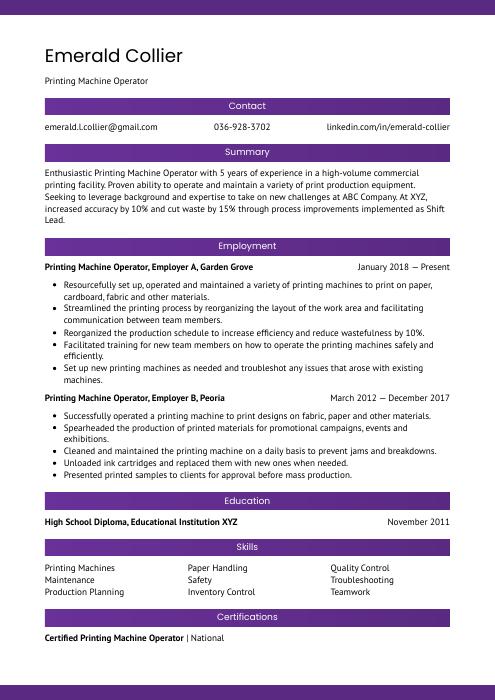 Jerboa
Jerboa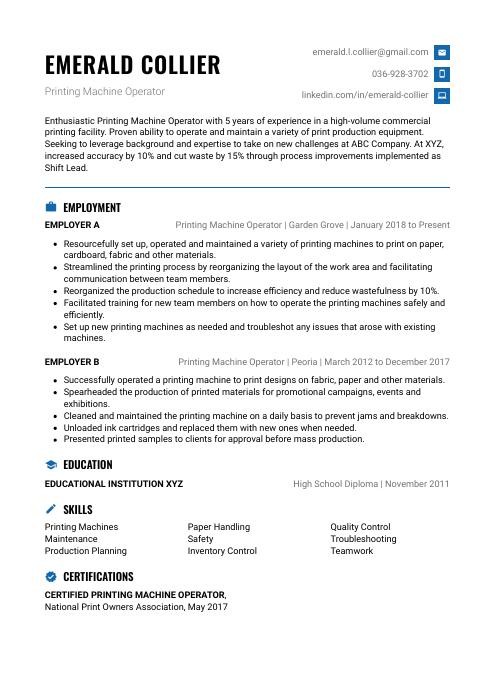 Echidna
Echidna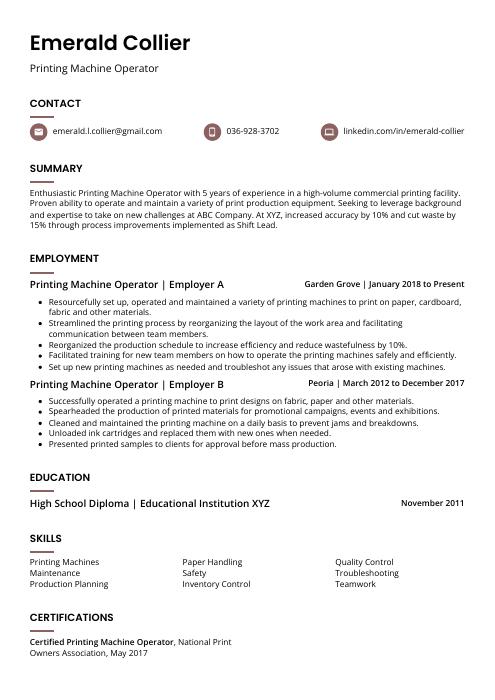 Fossa
Fossa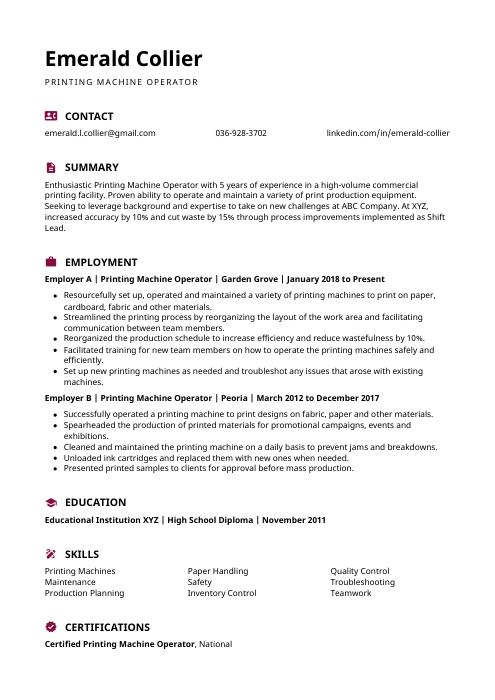 Hoopoe
Hoopoe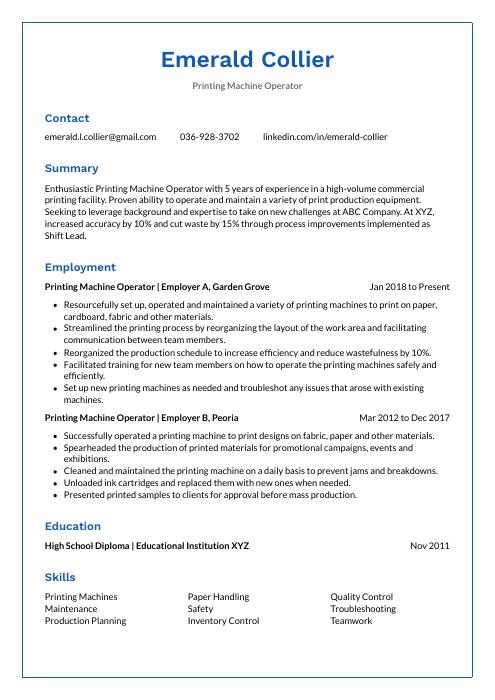 Markhor
Markhor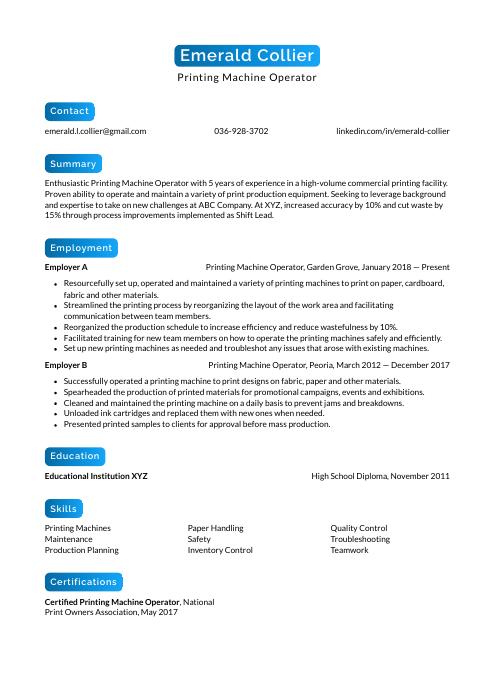 Kinkajou
Kinkajou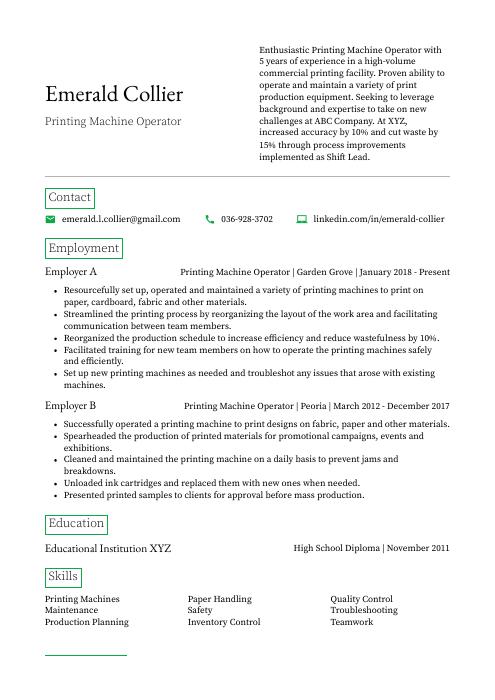 Quokka
Quokka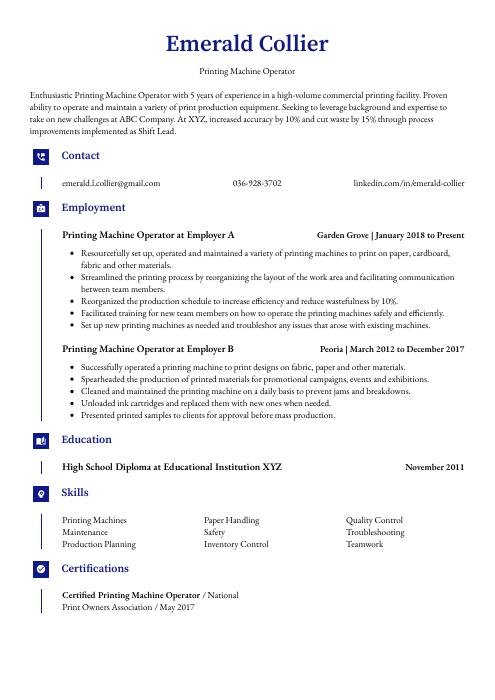 Gharial
Gharial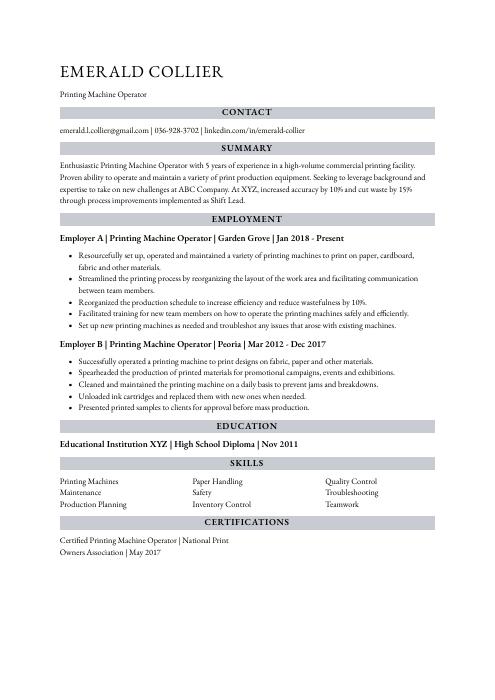 Numbat
Numbat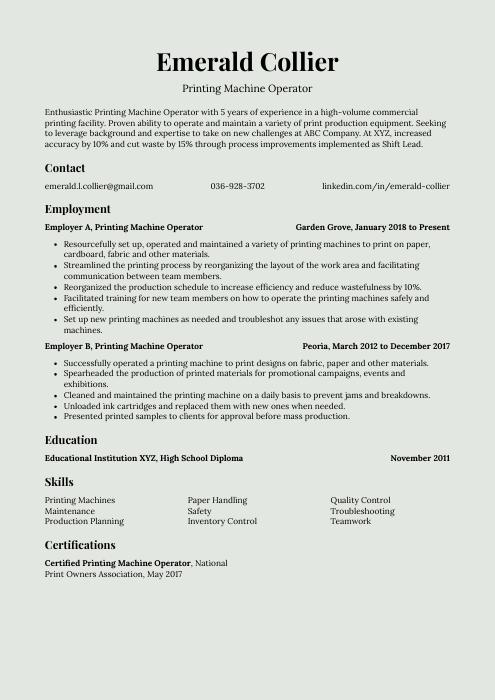 Saola
Saola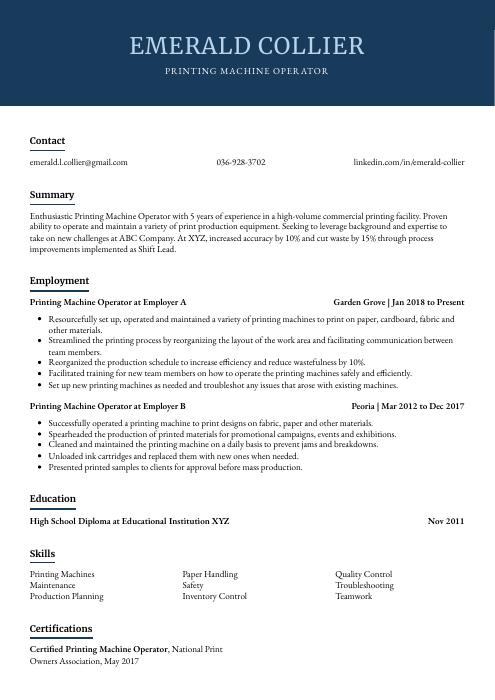 Bonobo
Bonobo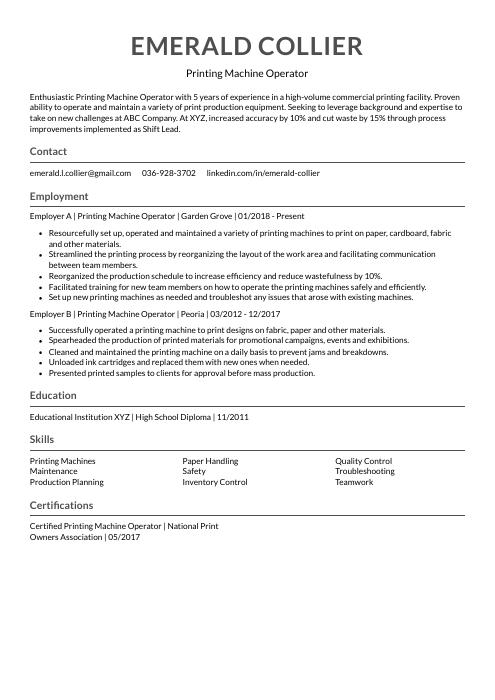 Indri
Indri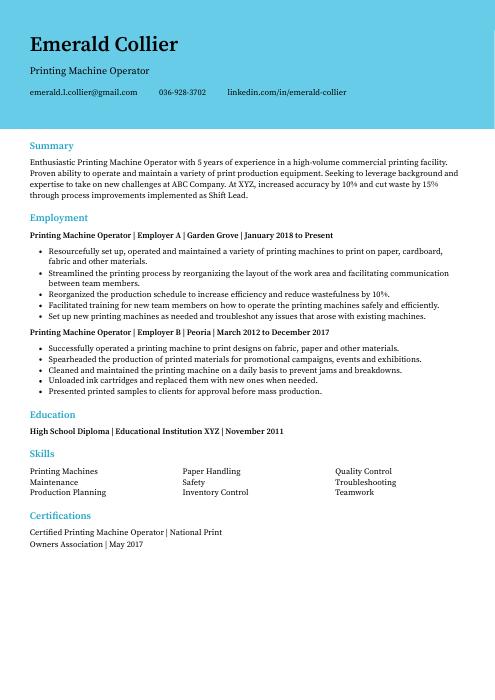 Dugong
Dugong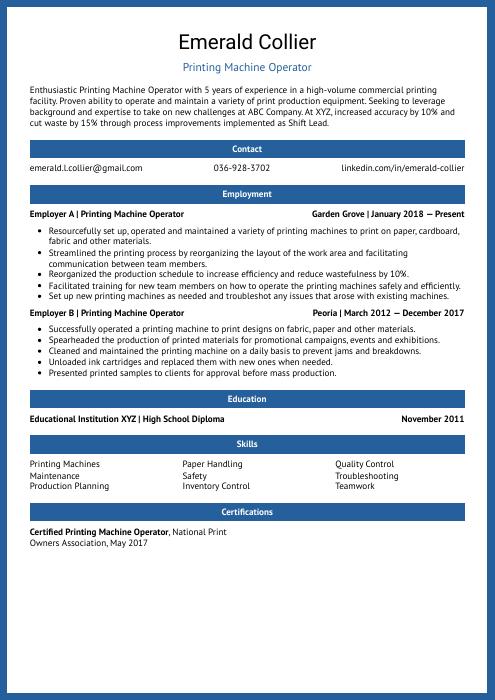 Ocelot
Ocelot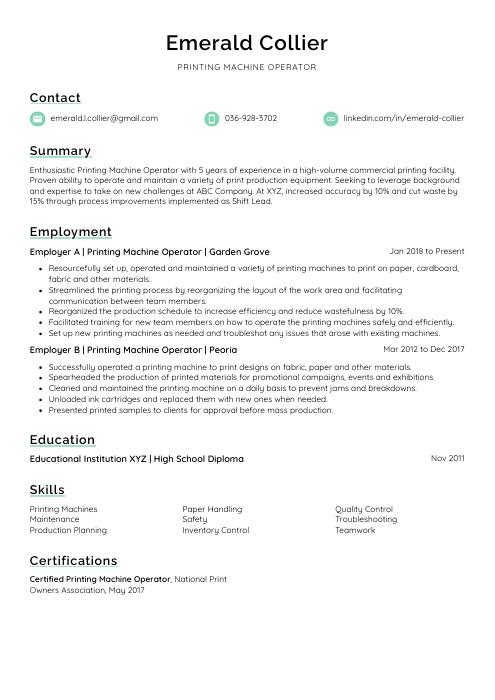 Lorikeet
Lorikeet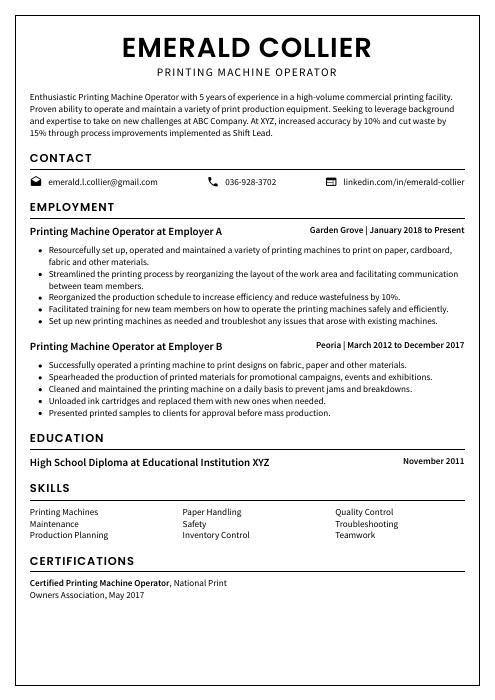 Cormorant
Cormorant Rezjumei
Rezjumei
